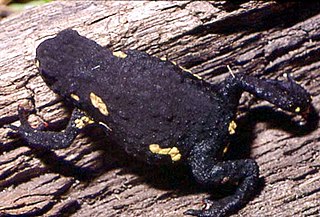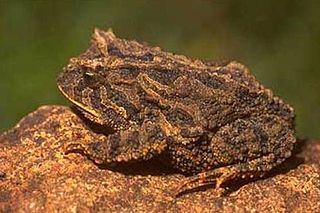
Blaira rubigina is a species of toad in the family Bufonidae. It is endemic to the southern Western Ghats, India, and is known from Silent Valley and Wynaad, both in Kerala. Its common names include Kerala stream toad, Silent Valley torrent toad, and red torrent toad.
Rhinella chrysophora, sometimes known as the Rio Viejo toad, is a species of toad in the family Bufonidae. It is endemic to the Cordillera Nombre de Dios on the Atlantic versant in north-central Honduras.

Atelopus cruciger, also known as the Veragua stubfoot toad or Rancho Grande harlequin frog, is a species of toad in the family Bufonidae. It is endemic to Venezuela and is known from the central Venezuelan Coastal Range. The species was already suspected to be extinct because, despite considerable effort, none had been found since 1986. However, in 2003, a small population was found, with few other locations discovered later. It is mainly threatened by chytridiomycosis. It is locally called sapito rayado.

Atelopus ignescens, the Jambato toad or Quito stubfoot toad or Jambato harlequin frog, is a species of toad in the family Bufonidae. It is endemic to the northern Andes of Ecuador. This once abundant species was believed to be extinct until its rediscovery in 2016. The specific name ignescens means "to catch fire," presumably in reference to the orange ventral color of this species.
The Nile Delta toad or Damietta toad is a species of toad in the family Bufonidae. It is endemic to Egypt, where it is found from the Nile Delta to as far south as Luxor. Its natural habitats are swamps, freshwater marshes, arable land, urban areas, seasonally flooded agricultural land and canals and ditches.

Rhinella scitula is a species of toads in the family Bufonidae. It is found in the southwestern Mato Grosso do Sul, Brazil, and in the adjacent southeastern Paraguay.

Melanophryniscus atroluteus is a species of toad in the family Bufonidae. It is found in northeastern Argentina, Uruguay, southern Paraguay, and southern Brazil. While in the past it was considered a subspecies of Melanophryniscus stelzneri, it might rather be conspecific with Melanophryniscus montevidensis. Common name Uruguay redbelly toad has been coined for it.
Melanophryniscus klappenbachi is a species of toad in the family Bufonidae. It is found in the Gran Chaco in northern Argentina, Paraguay, and Brazil, and possibly in Bolivia. Its specific name refers to Miguel Angel Klappenbach, a Uruguayan zoologist.
Melanophryniscus krauczuki is a species of toads in the family Bufonidae. It is found in the Misiones Province in northeastern Argentina and the Itapúa Department in the adjacent Paraguay. The specific name krauczuki honors naturalist and ornithologist Ernesto Krauczuk. Common name Krauczuk's redbelly toad has been proposed for this species.

Melanophryniscus montevidensis, also called Darwin's toad, is a species of toad in the family Bufonidae and the genus Melanophryniscus found in Brazil and Uruguay. Like other amphibians in its genus, its bright colors, defensive behavior, and rapid metamorphosis make it stand out. It also has a myriad of chemical compounds on its skin that could be used in biomedical applications.
Melanophryniscus pachyrhynus is a species of toad in the family Bufonidae. It is known from São Lourenço do Sul in southern Brazil and from Uruguay. Populations in Uruguay were until recently considered a different species and assessed as being vulnerable.
Melanophryniscus sanmartini is a species of toad in the family Bufonidae. It is found in Uruguay and southernmost Brazil. Its natural habitats are grasslands and rocky outcrops. Reproduction takes place in small streams. It is threatened by habitat loss caused by exotic tree plantations.
Melanophryniscus spectabilis is a species of toads in the family Bufonidae. It is known from western Santa Catarina and southern Paraná states, southern Brazil. The specific name spectabilis refers to the showy color pattern of this species.

Proceratophrys brauni is a species of frog in the family Odontophrynidae. It is endemic to South Brazil and has been recorded in the Paraná, Santa Catarina, and Rio Grande do Sul states. The specific name brauni honors Pedro Canisio Braun, a Brazilian herpetologist. Common name horn toad has been coined for this species.

Rhinella achavali is a species of toads in the family Bufonidae that is found in Uruguay and southernmost Brazil.

Ansonia kraensis is a species of toads in the family Bufonidae. It is found on the Kra Isthmus, Thailand. It is morphologically similar to Ansonia malayana from Malaysia, but differs from it in ventral coloration and larval morphology. The exact threats are unknown but are likely forest loss for logging and agricultural expansion.
Ansonia jeetsukumarani is a species of toads in the family Bufonidae. It is endemic to Peninsular Malaysia and known from its type locality, Fraser's Hill, and from Sungai Pergau. It is named in honour of Jeet Sukumaran, a biologist who has worked with Malaysian amphibians.
Atelopus pyrodactylus is a species of toad in the family Bufonidae. It is endemic to Peru and only known from its type locality in the northern section of the Río Huallaga basin, Department of San Martín, on the eastern slope of the Cordillera Central. The specific name pyrodactylus refers to the light orange fingers and toes of this frog.
Melanophryniscus admirabilis is a species of toads in the family Bufonidae. It is endemic to Brazil.

Melanophryniscus xanthostomus is a species of toads in the family Bufonidae. It is endemic to the state of Santa Catarina in southern Brazil. The specific name xanthostomus is derived from the Greek words xanthos (=yellow) and stoma (=mouth) and refers to the characteristic yellow stripe along its mouth. It is distinguished from congeneric species based on differences in size; having white and/or yellow spots on its forearms, mouth, belly and cloaca; the pattern and arrangement of warts; and the presence and number of corneous spines.










